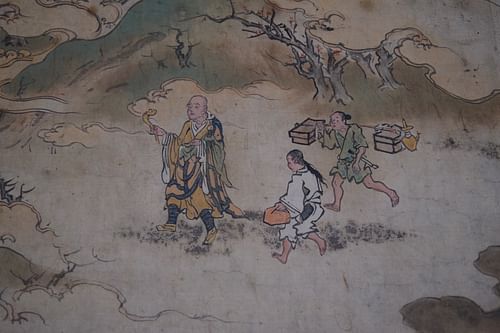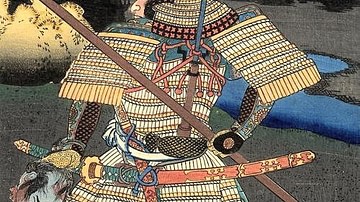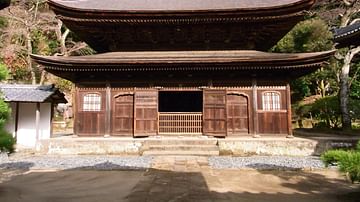
Hachiman is the ancient Shinto god or kami of war, divination, and culture. He is famously credited with sending the kamikaze or 'divine wind' which twice dispersed the invading fleets of Mongol ruler Kublai Khan in the 13th century CE. This assistance earned Hachiman the title of 'Protector of Japan'.
In the typical crossover seen in Shinto and Buddhism in ancient Japan, Hachiman is also considered a bodhisattva and protector of temples. The god was and continues to be worshipped at thousands of shrines of both faiths around the country, including the Todaiji in Nara and Hachiman shrine in Kamakura.
Historical Associations
Hachiman grew in importance during the latter half of the Heian Period (794-1185 CE) when many Buddhist shrines were established in his honour. The kami or spirit of Hachiman, especially the aspect representing culture, was particularly associated with two semi-legendary rulers: Empress Jingu and her son the deified Emperor Ojin (r. 270-310 CE); both were thought to have been avatars of Hachiman such were their great feats in warfare and culture in general - Jingu for invading Korea, and Ojin for inviting Chinese and Korean scholars to Japan. The first link between Hachiman and Emperor Ojin, figures which often become interchangeable in later times, appears in the Hachimangu mirokuji engi, composed c. 840 CE.
In the 11th century CE, Hachiman was selected as the symbolic head and patron of the powerful Minamoto clan, who could then claim lineage back to Emperor Ojin. Yorinobu (968-1048 CE) was the first Minamoto to make this claim in 1046 CE, and his son Yoriyoshi strengthened the family ties to Hachiman by citing the god as the reason for his victory in the Earlier Nine Years War in 1062 CE against the Abe clan. Yoriyoshi built a shrine at Yui-no-go in Sagami (moved to Kamakura in 1191 CE), and from that point on ever more shrines were built, all funded and protected by the Minamoto.
Yoriyoshi's son Yoshiie (1042-1103 CE) was an equally formidable warrior and he came to be known as Hachimantaro or 'First Son of Hachiman'. The legendary hero was named after the god following a dream by his father where Hachiman gave the youth a sword. Hachimanto was a famed archer, credited with being able to fire an arrow through three men at once and he was the main reason the Japanese defeated the Ezo people of northern Honshu.
Kamikaze
Hachiman's stature grew even greater in the Kamakura Period (1185-1333 CE) when he was worshipped by the growing bands of samurai warriors. Then the god enjoyed his greatest triumph when he was called upon to help save Japan as it faced its greatest ever threat from Mongol China. The god was credited with responding to these prayers and sending the kamikaze or 'divine wind', actually typhoons in the often treacherous waters between Japan and the Asian mainland, which dispersed two Mongol-Chinese-Korean invasion fleets sent by Kublai Khan in 1274 and 1281 CE. This miraculous escape from a numerically superior foe gave the Japanese priesthood plenty of ammunition for their sermons and sutras which led to a boom in conversions to Buddhism.
The notion of kamikaze, which had twice saved Japan, held such a strong hold on the public imagination that during the latter stages of WWII it was revived as the name for suicide pilots who were thought to be, like Hachiman, providing a last ditch effort to save Japan from imminent invasion.
Where is Hachiman Worshipped?
Hachiman was first worshipped locally and then more formally at the Shinto Usa shrine in northern Kyushu, founded in 725 CE. Quite why Usa was the first temple to honour Hachiman is not known. A figure of the god was transferred with great ceremony from Usa to the new Buddhist Todaiji monastery in Nara in 747 CE, ready to become its guardian spirit (chinju) when it officially opened two years later. In gratitude, the imperial court gave the Usa Hachiman shrine an exemption from taxes and a high court rank. Another important large temple complex was built in the god's honour at Iwashimizu, south of the capital Heiankyo (Kyoto) in 859 CE. A later temple but today significant is the Tomioka Hachimangu in Tokyo, founded in 1627 CE. Today there are some 25,000 Hachiman shrines across Japan.
The Hachiman cult, like many others, included belief in an oracle of the god in the form of female priestesses who, possessed of the kami of Hachiman, uttered sounds which were then interpreted by a male priest or saniwa. A compendium of the god's oracle proclamations, the Hachiman Usagu gotakusenshu was compiled in the 14th century CE by a Buddhist monk called Jinun.
The most famous declaration from an oracle of Hachiman was to the warrior Taira no Masakado (c. 903-940 CE). After defeating a number of warlords in the eastern provinces, Masakado made the remarkable claim in 939 CE that Hachiman had spoken to him through his oracle and declared that he should be made emperor. Naturally, the current emperor proved unwilling to step down or even share his throne and instead sent an army to defeat Masakado. The head of the 'new emperor' (shinko) as he called himself was sent to the capital Heiankyo and normal service resumed in the Japanese court. The tale was preserved for posterity in the mid-10th-century CE Shomonki ('The Story Of Masakado'). After this incident, Hachiman came to be considered the special protector of the imperial line.
Hachiman & Buddhism
In Buddhism Hachiman was officially made a bodhisattva, that is an enlightened one who remains on earth to guide the faithful, in 937 CE, the first of many kami from Shinto to be given that status in the crossover of faiths that was so typical of religion in ancient Japan. In time, the interpretation of Hachiman's oracular proclamations was entrusted specifically to male Buddhist monks. A celebrated wood statue of Hachiman as a bodhisattva, carved by the artist Kwaikei in 1201 CE, resides in the Todaiji monastery. Hachiman came to be worshipped not only as a daibosatsu or Great Buddha but also as the protector of Buddhist temples. In the Medieval Period Hachiman was considered an avatar of Amida (Amitabha) the Buddha of the Pure Land.
What Are Hachiman's Symbols & Associations?
Hachiman is associated with doves, which are his messengers, and his symbol is the bow and arrow, traditional weapon of choice (and not the sword) of the ancient gentleman Japanese warrior. Consequently, the sacred object (go-shintai) representing the god in his shrines is usually a bow and arrow, and sometimes stirrups too. A few temples have a calligraphy brush as their go-shintai to represent the god as patron of culture. Indeed, as Hachiman is also the kami of all things cultural, his shrine complexes often include secondary shrines dedicated to Tenjin, the Shinto god of scholarship and learning.
Festivals and ceremonies still held at Hachiman shrines include the popular omiyamairi ritual where young babies, especially boys, visit a shrine for the first time in their lives and receive purification surrounded by their family. Finally, Hachiman's Buddhist connections are evidenced in the Hojo-e festival, which began in 720 CE, where the faithful release animals and fish back into the wild.
This content was made possible with generous support from the Great Britain Sasakawa Foundation.






